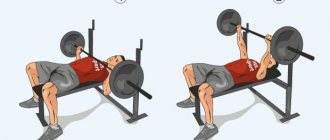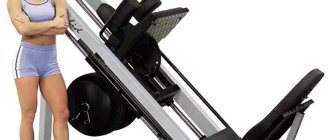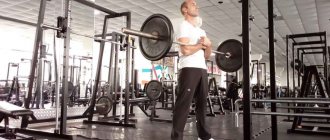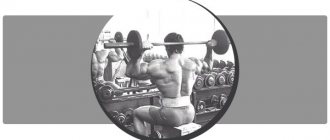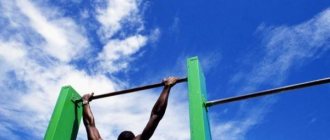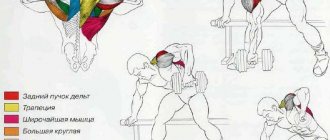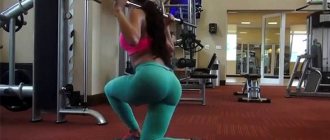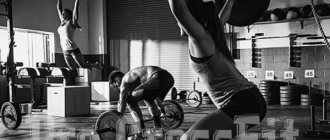Reverse crunches are a mandatory basic exercise that is included in a training program aimed at working the abdominal muscles. It copes with two important tasks - it tightens (strengthens) the lower part of the rectus abdominis muscle and helps burn the hated fat layer in this “problem” part of the body.
Features of the exercise
The rectus abdominis muscle is responsible for the abs. Its task is to allow the upper body to twist towards the pelvis and, on the contrary, for the pelvis to twist towards the upper body. This muscle is flat, it starts from the sternum and goes down to the lower abdomen. Tendons divide it lengthwise and crosswise into segments, forming the cubes that many people dream of. Thus, it is a single muscle that is not divided into top and bottom.
Any muscle can contract entirely or not contract at all. In any contraction, all muscle bundles and fibers are pressed. Direct and reverse abdominal crunches work the same abdominal muscle. As such, there are no specific exercises for the lower or upper abs.
Analyzing this information, we can ask ourselves why the lower abdomen lags behind the body in development, and what can we do to make the so-called lower abs sculpted too. physiology is such that there are fewer nerve endings in the lower abdomen than in the sternum, and in women there are even fewer of them than in men. Thus, the brain cannot generate an impulse to contract the lower abdomen with the same force as the upper one. This causes the upper parts of the abdominal muscles to be stronger than the lower parts. They get into work more easily, are more easily loaded, and because of all this, develop more easily. However, the body still develops harmoniously, and the lower abdomen progresses along with the upper. The results may just not be noticeable as quickly. All you need to do in this situation is just continue training.
To gain definition in your lower abs, you need to get rid of subcutaneous fat in this area. Therefore, it is better to stick to a diet that, in combination with exercise, will give the desired result.
The reverse crunch exercise involves the following feature. With this type of movement, namely, when we begin to twist from the lower part of the body to the upper, the lower region of the rectus abdominis muscle is better included in the work. Thus, we give the press a load from a slightly different angle. The same muscle works, but in a different way, which has a good effect on the effectiveness of the exercise. Training your abs from different angles allows you to make them strong and get the desired abs, if you also work on burning fat.
Let the reverse crunch be included in your training program along with other exercises, and not be its basis. Several different exercises develop the rectus abdominis muscle much better than the same exercise.
Advantages of this type of training
Pulling the knees towards the body (reverse crunch) is a universal solution; the exercise is effective for men and women, beginners and experienced athletes. It has numerous advantages, namely:
- strengthens the muscles of the entire abs, especially the lower section;
- the effect of training appears earlier than with traditional crunches;
- during execution, only the muscles of the abdominal wall are involved;
- minimal risk of injury;
- improved posture;
- correction of problems with the spine.
Like any other physical exercise, reverse crunches will be effective provided that the athlete eats properly. In parallel with classes, you need to go on a diet and adjust your diet. Having lost those extra pounds, you can safely start drawing the relief.
0
What muscles work during reverse crunches?
Reverse abdominal crunches, the technique of which will be discussed below, work the following muscles:
- The main load is placed on the rectus and oblique abdominal muscles.
- Also additionally included in the work are the back muscles, iliopsoas muscle, and quadriceps.
As a result of regular exercise, you will ensure active development of the abs . Your stomach will tighten, and over time you will be able to achieve the desired shape. In addition, the good thing about this exercise is that the load on the lower back when performing it is much less than with classic crunches. Also, when performed correctly, reverse crunches have a beneficial effect on posture.
Reverse crunches: technique of execution
The technique of performing reverse twists assumes that you will be able to grab the support with your hands. This will ensure that you maintain a stable body position, and you need to choose a place to perform the exercise with this in mind. In principle, experienced athletes can do without this, but beginners need a reference point to practice their technique. A horizontal bench is suitable for this. Let's look at how reverse crunches are done on a bench.
First, lie on your back, raise your legs and bend your knees. Now you need to raise your legs, bringing them closer to your body (your knees should move towards your chest), and also curling your buttocks. Once you reach the point of peak muscle contraction, stop for a second and return your body to the starting position by slowly lowering your legs. But don't put them on the floor. During the entire approach, they should be suspended - this is important for high-quality muscle development.
The positive phase of the exercise is done while exhaling, and the negative phase while inhaling, but in this case, exhalation should be done only at the point of peak contraction. That is, while performing the main movement, we gradually hold our breath. The optimal number of repetitions of the exercise is 10-25.
Most common mistakes
In most cases, reverse crunches are more harmful to the body - this is due to ignorance of the features of the exercise and the desire to get six-pack abdominal muscles as quickly as possible. As a rule, people neglect warming up or do not take it seriously enough.
Man performing a reverse crunch
Other common mistakes :
- jerks, high range of motion;
- abduction of the hip to the side - you can injure the spine;
- raising the head during exercise;
- hand movements;
- violation of breathing technique;
- non-compliance with diet;
- many repetitions - can cause hypertrophy of the rectus abdominis muscle.
Also a mistake is ignorance of contraindications. Reverse twisting is prohibited for back or spinal injuries, pancreatitis, stomach ulcers and some other diseases.
Beautiful abs
Reverse abdominal crunches are a fairly complex exercise, so it’s good if you can start training with an experienced trainer. Only after mastering the crunch technique can you do it yourself at home without risk to your health.
Watch the process of doing the exercise in the video :
Reverse crunch options
Once you have mastered the technique of classic reverse crunches, you can include more complex variations in your workout:
- Reverse crunches on an incline bench . Using an incline bench helps regulate the load. If you assume a head-down position, it will be easier for you to perform the movement, but the negative phase will be a little more difficult. If your head is up, your legs will need to travel longer distances, and the abdominal tension will be stronger.
- A close relative of reverse crunches is floor or hanging leg raises . Alternatively, you can replace reverse crunches on the floor or bench with hanging crunches on a wall bars.
- Reverse abdominal crunches can be performed using special leg weights . If you do the exercise on a bench, you can attach a tourniquet to the end of it and tie it to your legs. It will also be more difficult to move this way, and accordingly, the muscles will be worked out better.
- Full crunches are a fairly complex variation of the exercise. Here you need to raise your entire torso to a position perpendicular to the floor. You will need to rely on outstretched arms, as well as the trapezius muscles.
- Crunches on a chair . A not very common variation of the exercise, which, nevertheless, is very convenient, especially because it can be performed anywhere, even at the workplace or office. The essence of the exercise remains the same, but the position of the body changes. The athlete sits on a chair, pulls his knees to his shoulders, while tensing his abdominal muscles. To increase efficiency, you can make a counter movement of the body towards the legs, leaning forward a little.
Recommendations
To achieve maximum results from crunches, consider the following tips:
- Perform the exercise at maximum amplitude, since it is more effective with strong contractions of the abdominal muscles.
- In the initial stages of training, if you have difficulty lifting your legs, not to mention twisting your pelvis, you can bend your knees, leaving a small distance from the pelvis. This will lighten the load, because the closer the legs are to the chest, the easier it is to do the twisting. As your legs become trained, you should gradually straighten them.
- When performing the exercise, keep your hands on the floor or on a support, but not in the air.
- Do the crunch slowly to feel the tension in your abdominal muscles. When you reach the top point, you can further tense your muscles while holding the position for 0.5-1 second.
- Exhale when strengthening (twisting), and inhale when stretching (lowering).
- Pull your knees toward your head rather than toward your chest, which will help improve flexibility in the lumbar region. In turn, this will help improve the range of motion and stretch the lower back muscles.
- Do not lower your feet to the floor during the entire approach, as this will activate the muscles responsible for hip flexion and reduce the load on the abs.
- Hold your breath in the abdominal area to tighten the muscles and reduce the risk of injury by keeping your spine in a safe position.
By following the tips listed above, you can significantly increase the strength of your abdominal muscles, as well as more actively work your oblique abdominal muscles. If you combine training with a diet, you will be able to quickly reduce body fat and get the desired relief.
Contraindications and precautions
Reverse crunches are a safe option for working the abdominal muscles, which can be recommended even for those who have back problems. Therefore, there are no contraindications to their implementation as such. However, if pain or discomfort occurs during the exercise, it is recommended to complete the approach.
It is important to take into account common mistakes in this exercise and avoid them. So, don't ignore the warm-up. It is needed to warm up the muscles and prevent sprains and injuries. You should also not pull your knees towards your body at a right angle, as this can cause back injuries.
Also, when asking how to do reverse crunches, consider the following tips:
- During the entire exercise, the abs should be tense . If he relaxes even for a minute, this negatively affects the effectiveness of the exercise.
- Your knees should be bent at right angles . But this angle can be decreased or increased, thereby adjusting the difficulty of the exercise. The less you bend your knees, the more stress your abs will receive. Only athletes with a certain level of training can perform reverse crunches on straight legs. If you have chosen the right angle for yourself, try not to change it during the movement.
- If you cannot grab the support with your hands due to its absence, you can place them along your body, parallel to the surface, and lean on them when performing the movement.
- To get the coveted abs , you need two factors - a low percentage of subcutaneous fat and hypertrophy of the abdominal muscles. We will provide the first through diet and anaerobic exercise, the second through heavy strength loads, repeated 15-20 times. There is no point in doing reverse crunches a large number of times. If you find them easy, vary them with more complex exercises and use them as a warm-up.
- The lower back receives passive load when performing the exercise, so hyperextension can be used to warm it up.
- To increase the load , keep your head elevated during the positive phase of the exercise.
- Try to lift your pelvis as much as possible, but keep your spine straight. This will help work your abdominal muscles as effectively as possible and prevent injury.
- The negative phase also plays a big role, so try to lower your legs smoothly and slowly, lowering as your abs work.
- You can cross your legs at the knees to prevent them from dangling.
- The legs in this exercise only accompany the twisting, and the main movement should be carried out through the pelvis.
- Pay attention to your lower back . It shouldn't sag.
- The pelvis should twist exclusively in a vertical plane.
- Watch your breathing. Remember that effort is always done on the exhale, and relaxation is always done on the inhale.
- If you want to gain relief, try to perform at least 3-4 sets of 15-20 repetitions of the exercise.
If you follow these tips, then reverse crunches, photos of which will allow you to understand more about their technique, will be as effective as possible.
About secrets and subtleties
The exercise, as mentioned above, has subtleties, knowing which it is easy to make it more productive:
- all movements are made slowly and under control;
- the abdominal muscles are consciously compressed at the top point;
- the hips are lowered to the floor slowly, without throwing;
- along the entire trajectory, the angle in the knee joint should not change, remaining straight;
- You cannot take your hands off the mat;
- Deflection in the lower back is not allowed - it is pressed tightly to the floor;
- the head is not lifted from the floor;
- inhalation is performed in the stretching phase (during lowering), and exhalation is done in the contraction phase;
- It is recommended to do 3-4 sets, each with 12-15 repetitions.

